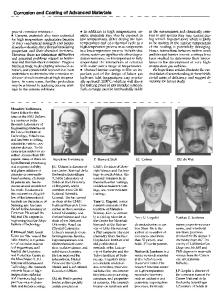A Polyaniline Coating Material for Inhibiting Corrosion in Marine Environment
- PDF / 37,725 Bytes
- 6 Pages / 612 x 792 pts (letter) Page_size
- 101 Downloads / 351 Views
Yuan Lin, Sze C. Yang, Robert Clark, Univ of Rhode Island, Chemistry Department, Kingston, RI; Richard Brown, Univ of Rhode Island, Chemical Engineering Department, Kingston, RI ABSTRACT The conventional molecular ion doped polyaniline undergoes dedoping in sea water because the sea water, with pH = 8, induces deprotontation of polyaniline. In this article we report polyaniline complexes that remain conductive in sea water. These complexes are useful for corrosion protection of metals in marine environment and for chromate replacement coatings. The reason for the pH stability of these polyaniline complexes was discussed. The polymeric complexes of polyaniline were used as an additive in an epoxy primer coating on AL7075-T6 without surface pre-treatment of the metal. Corrosion tests show that these polymeric complexes of polyaniline are effective for improving the corrosion inhibition in seawater for aluminum alloys. INTRODUCTION Polyaniline has been studied as a coating for preventing corrosion of steel and aluminum alloys1 . Previous studies suggest that the corrosion inhibition may be originated from the electroactive interactions between the conducting polymer and the metal surface. Electrochemical impedance spectroscopy (EIS) and potential dynamic studies suggest that the conducting polymers help passivate the metal surface. Reference 1(k) presents a different mechanism for corrosion protection of aluminum alloys through extraction of copper from copper containing aluminum alloys by emeraldine base and sulfonated polyanilines thereby reducing the copper/aluminum galvanic couple. Corrosion is a significant problem for lightweight high-strength aluminum alloys because the copper-rich region of the alloy promotes corrosion. The corrosion rate is fast in the presence of the chloride ions. The currently used corrosion inhibitors for aluminum alloys are chromate compounds which have problems with their toxicity. The conducting polymers are potentially useful as a replacement for chromates2 . H H Figure 1 shows a deprotonation reaction that 2+ N N converts polyaniline from the conductive emeraldine salt to the insulating emeraldine base. In the N N H H emeraldine salt form, the mobile charge carriers are the positively charged polarons. In the presence of a proton acceptor, such as a base or water, the -2 H + electronic structure of the emeraldine salt rearranges to form the emeraldine base which is an insulator. H N N The deprotonation reaction of chloride doped 3 polyaniline has a pKa value about 4. Therefore the N N H conductive form of polyaniline undergoes the conductor-to-insulator transition when it is placed in an aqueous solution with pH value higher than 5 or 6. The electrical conductivity of polyaniline decreases by 5 to 6 orders of magnitude in the conductor-to-insulator transition.
[
]
[
]
Although there have been reports that the emeraldine base form exhibit corrosion inhibition behavior, our laboratory tests show that the conductive form is more effective than the insulator form for protecting alu
Data Loading...











